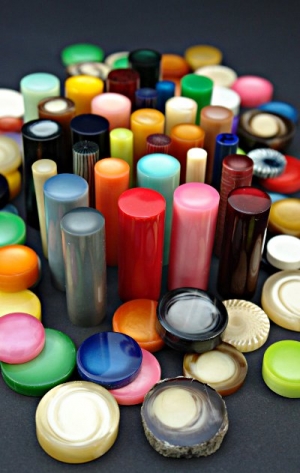From casein to Galalith
Milk contains proteins, minerals, sugar and fatty acids. Once skimmed and coagulated, milk becomes casein (from the latin caseus : cheese). Insoluble in water, casein swells in it. Conversely, it dissolves in alkaline solutions. It is also hard to burn.
Known long ago as a binder of colour pigments, as a glue and later in the production of photographic paper, the word appeared in french in 1350 in a book entitled "Le Secret des Arts" (The Secret of Crafts).
In 1870, casein figures in German and British registered patents for colours imitating horn, marble and porcelain.
In 1893, a French self-taught chemist, Alfred Trillat, while studying formol aldehyde, discovers that formol hardens albuminoid matters and makes them insoluble. Albumins are the components of casein. This discovery is not followed up in his country. But Trillat has invented a process for the mass production of formol.
In 1895, the German chemists Wilhelm B. Krische and Adolf Spitteler come to the same conclusion as Trillat : using formol to harden casein. Two years later they come up with a new hard material that competes with Celluloid and can be lathe-worked, ground and polished.
Especially hard, Galalith is odourless, non-inflammable and resistant to acids and solvents. Like wood, it can be sawed, lathe-worked, drilled, milled, glued, polished mechanically or by hand. At the early stage of production, it can be dyed in many colours and given various aspects: ivory, ebony, marble, scales, horn, etc… It cannot be moulded, so it is produced in sheets, rods and tubes and must be workedmanually. Its main flaw is being highly sensitive to humidity. But the hardening process takes time.
For example: Thirteen days for a sheet of 4 millimetres of casein in a bath of formol at 4%, two months for a sheet of 8 mm and three months for a 10 millimetres one.
The industry of Galalith
Two companies, one german the other french, started producing hard casein on an industrial scale, buying natural casein from a factory in the North of France.
In 1905, the newly created International Galalith Gesellschaf Hoff & Company bought its french rival, gone bankrupt, thus creating a monopoly of Galalith in Europe. Galalith (milk stone in Greek) became a registered patent in 1906 and a house name. In 1914, International Galalith produced hundreds of tons and employed more than 3,000 workers.
The First World War (1914-18) brutally stopped production in Germany as most of its casein was imported from France. Meanwhile, production of celluloid was restricted, being highly inflammable and also used in nitrocellulose, an explosive.
French producers now had a free way. Many commonly used manufactured devices were in Galalith: combs, spectacles, jewels, knife handles, knitting needles, buttons, electrical insulators, etc…
In the Thirties, production of Galalith declined. The Great Depression weighed heavily on the sector and competition was fierce. In 1940, eight companies had survived, producing 2.700 tons of Galalith that year.
After WW II
Interrupted by the Second World War (1939-45), the production of Galalith started again in 1947 with one company standing out, Les Etablissements Feuillant at Ezy-sur-Eure in Normandy, churning out more than 530 tons a year. Some 600 to 800 workers produced the material and 7,000 to 10,000 manufactured it.
From 1975 polyester resins, cheaper to manufacture, took over the market. Producing milk had become much more profitable than making casein. The closure of Les Etablissements Feuillant in 1981 tolled the end of Galalith.

Old galalith samples